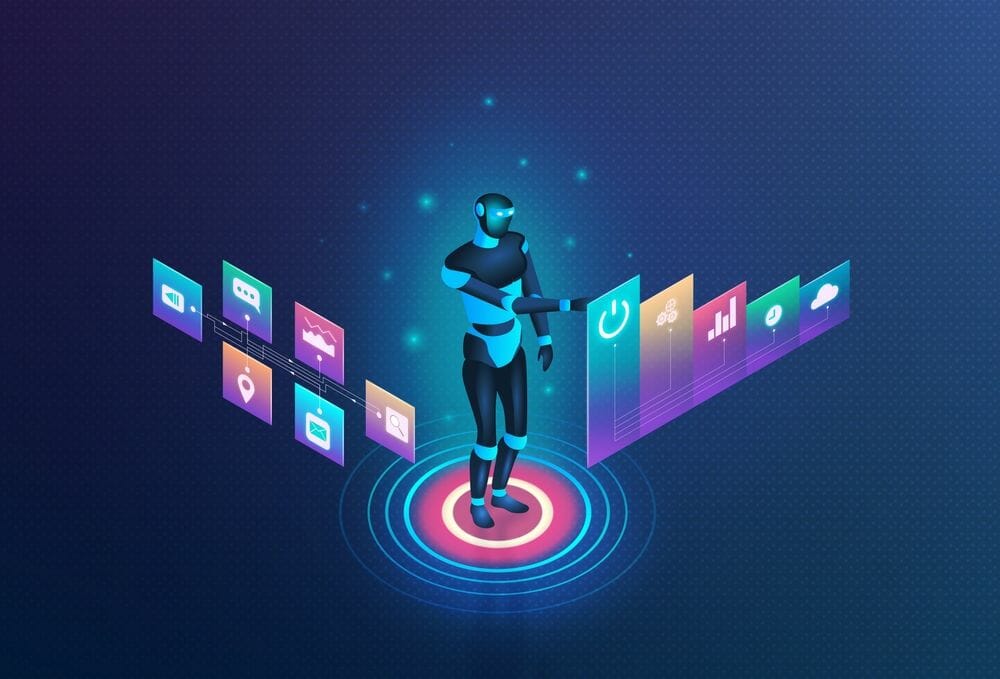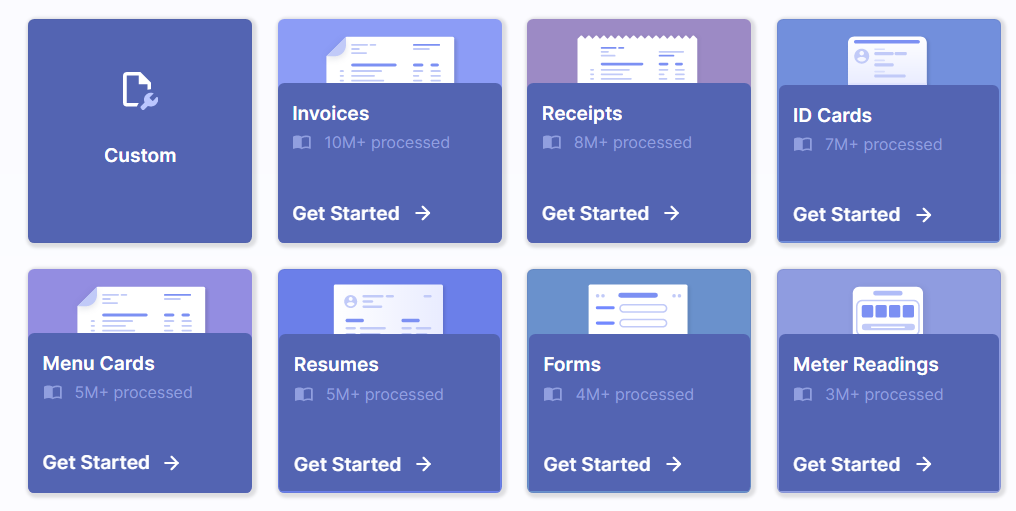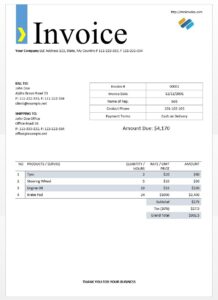
Hyperautomation was rated the number one technology trend for 2021 by Gartner, the IT research and advisory firm. It is slated to be the next driver of the digital revolution in the business domain and aims to integrate all automated activities under one common platform that is unique to an organization.
Let us see what hyperautomation is, and how it stands in benefitting any enterprise.
Table of Contents
- What is Hyperautomation
- How Hyperautomation works
- Benefits of Hyperautomation
- Where is Hyperautomation used
- How to implement Hyperautomation
- Hyperautomation with Nanonets
- Takeaway
What is Hyperautomation
Gartner defines Hyperautomation as “the orchestrated use of multiple technologies, tools or platforms, including Artificial intelligence (AI)m Machine Learning, Event-driven software architecture, Robotic process automation (RPA), Business Process Management (BPM) and intelligent Business Process Management Suites (iBPMS), Integration platform as a service (iPaaS), low-code/no-code tools, and packaged software”. It marks the current advanced phase of digital process automation that has evolved from and after the digital workflow management systems developed in the 1980s.
Hyperautomation brings together the various components of any business – workforce, and workflow – to enhance the efficiency of operations and thereby, the bottom-line.
How Hyperautomation works
Hyperautomation is made of three components – automation, orchestration and optimization.
- Automation is the foundation of any hyperautomation strategy. It usually consists of smaller automation programs and tools that help with specific tasks. RPA, for example, is an automation system. Multiple automation tools come together in hyperautomation.
- Orchestration is the bringing together of the automation tools into a larger framework so that all tasks are interconnected and work in sync with each other.
- Optimization is the extra layer of intelligence that allows optimization through validations and continuous learning and helps in better integration of the automation and orchestration processes.
Hyperautomation provides a framework for the strategic deployment of various automation technologies separately or in tandem. These technologies could include:
- Robotic Process Automation (RPA): the automation of repetitive, structured tasks in accordance with a set of predefined rules.
- Machine Learning (ML): the use of algorithms that teach the machine to learn from tasks without the need for human intervention. The rules are modified and appended as the computer learns from existing data.
- Artificial Intelligence (AI): the ability of machines that can make human-like decisions by emulating the logical thinking process of humans.
- Big Data: the technology that allows storing, analyzing, and managing enormous amounts of data to identify patterns and create optimal solutions.
- Cobots: collaborative robots that work with the human in the loop for human-centric activities
- Chatbots: the use of OCR, AI, ML, and NLP that can help a computer hold a real-time conversation with a human using text or speech.
- Intelligent business process management suites, integration platforms as a service (iPaaS), and information engines.
- Process mining and task mining tools for pattern recognition and prediction.
The common steps in a typical hyperautomation platform include:
- Linking processes, workflows, and environments and creating a common platform from which the independent automation processes can work.
- Identifying structured and unstructured data and other inputs from various sources and storing them in a self-consistent database for use by the various automation processes
- Predicting outcomes such as efficiencies and return on investment (ROI) with the collated data from which there is continuous learning during operation.
Hyperautomation can be used to create a digital Doppelganger for the organization, called the DTO, (Digital Twin Organisation). The DTO is a digital representation of the business operation or workflow and can be used to simulate interactions and help in making predictions in real-time.
The automation of mundane recurring tasks can increase the speed, accuracy, and consistency of operations. These lead to the improved efficiency and profitability of the business.
Benefits of Hyperautomation
- Coherence of operation: While automation is already employed in many organizations to carry out specific tasks and operations, they are often uncoordinated. A hyperautomation platform can bring together all these disparate automation tools into a single platform, thereby bringing in data and task coherence.
- Time savings and faster turnaround times: The time savings afforded by automation of tasks can be undone if there is no overarching process to integrate them within an organization’s larger work umbrella. The seamless links between the various automated tasks afforded by hyperautomation can help avoid such delays and bottlenecks in the daily operations of the company.
- Cost savings: Manual business processes, especially those that coordinate activities from multiple departments and branches of an organization require considerable human capital. McKinsey showed that 45% of current paid activities that cost an equivalent of $2 trillion in total annual wages, can potentially be automated. Furthermore, manual performance of redundant, potentially automatable tasks decreases the productivity of the company and low productivity can cost employers around USD 1.8 billion dollars annually.
- Error reduction: Having a common platform that all the company’s individual automation tools use and the coherence of data prevents errors that are common in disparate automation activities.
- The use of digital twins. Digital twins can showcase undercurrents and previously invisible interactions between functions, processes, and performance indicators.
- Conserving human capital: Through the deployment of OCR, NLP and AI/ML, hyperautomation can eliminate human involvement in mundane, repetitive activities. It can free employees otherwise engaged in tasks such as dataentry or first-level customer interaction from these time-consuming tasks.
- Transparency: Hyperautomation can centralize processes and enhance transparency across the board while also logically integrating the business functionalities spread out across the organization. It also sets up security measures and traceability of information, which ensures better compliance with relevant regulations.
- Audit-readiness: Hyperautomation not only allows standardization of operations but also ensures maintenance of records of all stages of a business process, thereby creating an audit trail.
- Decision making: Recognizing and prioritizing companywide processes and tasks can be challenging especially when there are too many parameters that affect the functioning of the company. The AI features of hyperautomation can help in quick predictions based on data and history, which can help in management-level decisions.
- Expansion: As the client base and operational portfolio expand, disparate automation can become unwieldy and lead to more management challenges. Hyperautomation enables streamlining of all business processes, thereby allowing the business to scale.
Where is Hyperautomation used
Healthcare
Healthcare spans many interdependent and interrelated areas such as patient data management, healthcare staff management, infrastructure maintenance, quality control, billing, etc. These individual activities are handled by separate departments and collating all data and processes under a single platform will help in better efficiency of the entire healthcare system. In addition, it can also ensure compliance with regulations and enhance reliability among the public.
Supply chain
The disruption of the supply chain during the pandemic has resulted in difficulties along every node of the chain. The hyperautomation of inventory management, procurement, scheduling, and transporting information can help in predicting delays and thereby making and triggering contingency steps to avoid large-scale disruptions.
Finance and Accounting
The advantages of hyperautomating the financial aspects of a company’s operations are increasingly being recognized by businesses. This is particularly evident in the operations of the Accounts Payable Department which provides financial, administrative, and clerical support to the purchase process of a company. The operations of the AP department must seamlessly integrate the various functions of the procure-to-pay process that spans purchase order management, vendor management/communication, invoice management, product tracking, and payment. Hyperautomating AP operations, such as invoice management and purchase order management, can help organize the procurement process in companies.

The Retail Industry
Hyperautomation is expected to become essential in the retail sector, especially in e-commerce applications. It can enhance the efficiency of front-end processes such as targeted, social media content generation, customer management, etc., and also integrate it with back-end processes such as inventory management, the procure-to-pay process, invoicing, and shipping tasks. Hyperautomation can also analyze operational patterns and customer behavior and use the information for accurate decision-making that increases revenue and profitability.
How to implement Hyperautomation
Setting up a hyperautomation platform may appear challenging because of the perceived enormity of integrating hitherto disparate systems within an organization. However, a systematic assessment of the business processes of the company and designing efficient workflows for hyperautomation would ease the process.
A hyperautomation practice involves identifying the tasks that can be and need be automated, choosing the appropriate automation tools, and merging or extending their capabilities using various flavors of AI and machine learning. Some of the factors to be considered in hyperautomation include:
- The functionalities that must be integrated: Each company has its own levels and scale of automation, in addition to practices and policies. This is why a thorough design of workflow is essential before embarking on the hyperautomation journey. This workflow will help clarify how the hyperautomation platform would align with the overall rules and logistics of the business.
- Budget: The amount of money to be invested in setting up a hyperautomation system depends on the scale of the business, the bottom-line and the investment potential of the company
- Ease of use: While hyperautomation largely eliminates human intervention, there is always a minimum level of human involvement needed, at least at the setting up stage. There are experts who can help in setting up such platforms. The need for training and tech support must also be addressed before choosing the right tool for the purpose.
- The extent of spread and collaboration: Most departments/teams/units in large companies are interconnected in their activities and may use automation tools that are linked or not. The hyperautomation process must be able to provide access at various levels and allow easy collaboration among all participants. There also needs to be provision to include various levels of approvals in the process.
The eventual success of hyperautomation in any enterprise depends upon the company’s understanding of the process, the technological maturity/prowess of the company, the ability to integrate legacy technologies into the hyperautomation portfolio, the motivation of employees to learn and adapt, and the managerial dynamics within the company.
Hyperautomation with Nanonets
Nanonets is an OCR software that can be part of the larger hyperautomation system because it leverages AI & ML capabilities to automatically extract unstructured/structured data from PDF documents, images, and scanned files.
The AI-driven cognitive intelligence of Nanonets allows handling of semi-structured and even unseen document types while improving over time. The Nanonets algorithm & OCR models learn continuously. They can be trained or retrained multiple times and are very customizable.
The Nanonets API provides high speeds and great accuracy in line item extraction of data and drives automation for line item management. The output can be customized, to only extract specific tables or data entries of interest.
The versatility of Nanonets arises from its ability to perform the following tasks:
- Accurate detection of the table structure of a line item containing documents like forms.
- All the line item entries that are present in the forms like name, product, price, total sum, discounts, etc.
- The data can be extracted as JSON output that can enable the building of customized apps and platforms.
- While offering a great API & documentation for developers, the software is also ideal for organizations with no in-house team of developers.
This versatility allows the use of Nanonets in a variety of functions and departments within an organization – the accounts payable, HR, inventory management, etc. This makes it an ideal system to be integrated into a hyperautomation setup.

Additional factors that make Nanonets a good addition to hyperautomation are:
- It is a truly no-code tool
- Easy integration of Nanonets with most CRM, ERP, content services, or RPA software.
- No post-processing needed: Nanonets OCR can recognize handwritten text, images of text in multiple languages at once, images with low resolution, images with new or cursive fonts and varying sizes, images with shadowy text, tilted text, random unstructured text, image noise, blurred images and more.
- Works with custom data through the use of custom data for training OCR models.
- Multiple input recognition: Nanonets OCR can recognize handwritten text, images of text in multiple languages at once, images with low resolution, images with new or cursive fonts and varying sizes, images with shadowy text, tilted text, random unstructured text, image noise, blurred images, and multiple languages
- Independence from formats: Nanonets is not bound by the template of documents at all. You can capture data cognitively in tables or line items or any other format.
Takeaway
Hyperautomation is a holistic approach to future business management, that orchestrates and optimizes a range of technology including AI, robotic process automation (RPA), and process mining. It can eliminate manual repetitive processes and streamline the entire gamut of operations of a business with efficient workflows to deliver better products/services and increase profit. Hyperautomation will be the way to stay competitive in an increasingly digital world and embarking on it would be the path to future competence.
- &
- 2021
- access
- accurate
- across
- activities
- addition
- advanced
- advantages
- advisory
- AI
- algorithm
- algorithms
- All
- Allowing
- already
- among
- amount
- amounts
- annual
- Annually
- api
- applications
- approach
- apps
- architecture
- around
- artificial
- artificial intelligence
- audit
- Automated
- Automation
- Back-end
- become
- being
- billing
- Billion
- board
- Building
- business
- businesses
- capabilities
- capital
- chain
- challenges
- cognitive
- collaboration
- Common
- Companies
- company
- compliance
- content
- control
- Conversation
- coordinate
- could
- Creating
- CRM
- Current
- custom
- data
- data management
- Database
- delays
- deployment
- Design
- designing
- Detection
- developed
- developers
- digital
- digital twin
- Disruption
- documents
- dollars
- domain
- driver
- dynamics
- e-commerce
- efficiency
- efficient
- eliminate
- employees
- enormous
- Enterprise
- especially
- essential
- example
- Expand
- expected
- experts
- factors
- faster
- Features
- financial
- Firm
- following
- format
- forms
- Foundation
- Framework
- Free
- functioning
- future
- generation
- good
- great
- Handling
- having
- healthcare
- help
- helps
- High
- history
- hold
- How
- hr
- HTTPS
- human
- Humans
- identify
- identifying
- image
- implement
- include
- Including
- Increase
- individual
- information
- Infrastructure
- integrate
- integrated
- integration
- Intelligence
- Intelligent
- interaction
- interest
- inventory
- investment
- IT
- Languages
- large
- larger
- lead
- LEARN
- learning
- Legacy
- Level
- leverages
- Line
- links
- logistics
- machine
- machine learning
- Machines
- MAKES
- Making
- management
- managing
- manual
- Media
- Mining
- ML
- models
- money
- more
- most
- Noise
- number
- offering
- Operations
- optimization
- orchestration
- order
- organization
- organizations
- Other
- otherwise
- paid
- pandemic
- participants
- Pattern
- payment
- performance
- phase
- platform
- Platforms
- policies
- portfolio
- potential
- practice
- prediction
- Predictions
- present
- price
- process
- Process Automation
- processes
- Product
- productivity
- Profit
- profitability
- Programs
- provide
- provides
- public
- purchase
- purpose
- quality
- range
- real-time
- recognize
- recognized
- records
- regulations
- relevant
- require
- research
- retail
- revenue
- Robotic Process Automation
- ROI
- rpa
- rules
- Scale
- seamless
- sector
- security
- service
- Services
- set
- setting
- Shipping
- So
- Social
- social media
- Software
- Solutions
- speed
- spread
- Stage
- stands
- stay
- Strategic
- Strategy
- success
- supply
- supply chain
- support
- system
- Systems
- tasks
- team
- tech
- Technologies
- Technology
- Thinking
- Through
- time
- time-consuming
- together
- tool
- tools
- Traceability
- Tracking
- Training
- Transparency
- unique
- us
- USD
- use
- usually
- various
- What
- What is
- WHO
- within
- without
- Work
- Workforce
- world













